One issue with WiFi that crops up regularly is that of selecting which channel to use. This is a subject on which several previous articles have been written, however the discovery of a 2004 paper by Cisco entitled 'Channel Deployment Issues for 2.4-GHz 802.11 WLANs', looks at whether or not it is possible to seat WiFi hotspots on neighbouring channels and the effect that channel separation has on performance. Though the paper is now nearly 10 years old, it remains one of the only references on the issue.
What the paper says, quite rightly, is that the extent to which a WiFi hotspot will cause interference to a neighbouring one is dependent on the extent to which interference from one is received by the other. This is partially a factor of the distance between them but is also related to their frequency separation. What the paper shows is that, in the USA, where there are 11 2.4 GHz WiFi channels available, only the set of channels 1, 6 and 11 are usable in such a way that a hotspot on one will not interfere with hotspots on the others. The paper examines what would happen if the set of channels 1, 4, 8 and 11 were used for four neighbouring hotspots. Cisco even did some tests which showed the following results:
| Channels Used | Throughput per Client |
|---|---|
| 1, 1, 6 and 11 | 601 KB/second |
| 1, 4, 8 and 11 | 349 KB/second |
What the results indicate is that even though, in the first test, two of the hotspots were on the same channel, the average throughput was increased over the four channel example because the overall level of interference was reduced. The paper also notes that WiFi hotspots on the same channel recognise each other and use various measures to try and avoid interfering whereas those on neighbouring channels just see interference on the channel. This is one reason why it is better to use a set group of channels in a given area (and to see what your neighbours are doing) rather than just pick a channel at random.
Having read this paper, the question that immediately arose was whether or not the fact that in Europe (and certain other parts of the world) there are 13 2.4 GHz WiFi channels available and not 11, offers up the possibility of a four channel arrangement that actually works - channels 1, 5, 9 and 13. The diagrams below show the emissions that are produced by the hotspots in the original three and proposed European four channel arrangements.
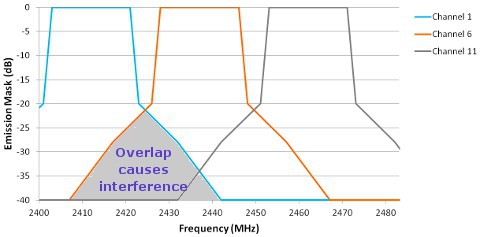
Three channel arrangement
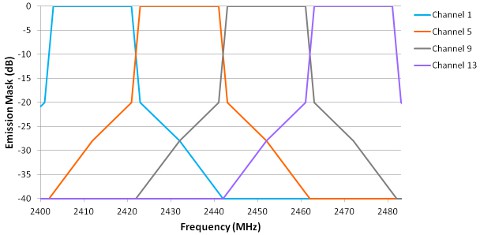
Four channel arrangement
The amount of interference that is caused between devices is the overlapping area of the emissions of one transmitter with that of the receiver of a device on another channel (shown shaded on the first diagram). Using the standard emission mask to represent the emissions from one device (in reality they are usually lower than this) and using the same mask to represent the characteristics of the receiver of another (again a reasonable assumption) the extent to which a transmission on one channel is received by a receiver on another channel can be easily calculated.
The chart below shows how much of the emissions of a transmitter on a given channel are received by a receiver which is offset by a certain amount from that channel.
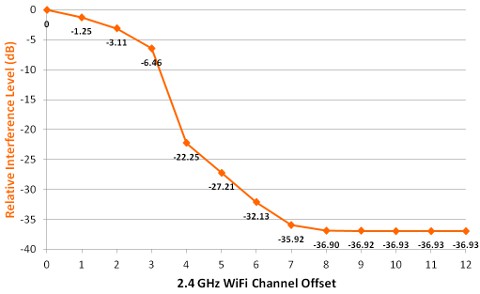
An offset of zero means that both are on the same channel and therefore the interference is at 100% (shown as 0 dB). When the transmitter and receiver are separated by one channel (eg one hotspot is on channel 6, the other on channel 7), the amount of interference that one causes the other reduces by 1.25 dB (representing around 75% of the original value). When this offset is increased to two channels (eg one hotspot on channel 5, the other on channel 7), the interference falls by 3.1 dB (or around 50%). At the extreme, when the offset reaches 8 channels or more, the interference has fallen by nearly 37 dB (or to around 0.02% of the original value). So...
- In the case of the use of channels 1, 6 and 11 where the offset is 5 channels it can be seen that the level of mutual interference between hotspots would be -27 dB (or around 0.2%).
- In the case of the use of channels 1, 5, 9 and 13 where the offset is 4 channels it can be seen that the level interference between hotspots would be -22 dB (or around 0.6%).
- In the case of the use of channels 1, 4, 8 and 11 where the offset falls to 3 channels, the level interference between hotspots rises dramatically -6.4 dB (or around 23%).
It is therefore, perhaps, no great surprise that using the four channel arrangement posed by Cisco that interference levels increased to the point that the throughput dropped by nearly half. It does, however, look feasible that in Europe the use of a four channel arrangement that uses channels 1, 5, 9 and 13 might be feasible. A lot will depend on the characteristics of the receivers in use and whether they are as good as the emission mask.
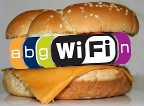 Don't worry if you haven't understood everything presented here, the salient points are:
Don't worry if you haven't understood everything presented here, the salient points are:
- In the USA and other places where there are only 11 WiFi channels available, throughput will be maximised if everyone in the same neighbo(u)rhood stuck to using only channels 1, 6 or 11.
- In Europe and other places where there are 13 WiFi channels available, it seems quite feasible that if everyone sticks to using channels 1, 5, 9 or 13, the performance of everyone's WiFi hotspots would be maximised.
- Using a WiFi hotspot on a channel which is offset from a nearby hotspot by 1, 2 or 3 channels is a recipe for both hotspots to suffer interference and have degraded performance.
- Randomly picking a channel for your WiFi hotspot (eg. setting it to your lucky number) is a recipe for poor performance all round.
It is perhaps worth noting that in the 5 GHz band, no such restrictions apply as, sensibly, all of the available channels are mutually independent from all the others!
Unfortunately, unlike Cisco, the Wireless Waffle team do not have a shed full of WiFi hotspots that can be used to do tests on throughput. Perhaps someone might like to take up this challenge and let us know what the results are?
add comment
( 4034 views )
| permalink
| 



 ( 2.7 / 2971 )
( 2.7 / 2971 )




 ( 2.7 / 2971 )
( 2.7 / 2971 )
Thursday 7 February, 2013, 13:15 - Much Ado About Nothing
Posted by Administrator
Posted by Administrator
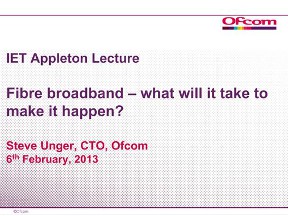 At the IET, Ofcom's chief technology officer, Steve Ungar, gave the annual IET Appleton lecture (parts of which can be viewed on the IET.tv web-site). The title of the lecture was 'Superfast Broadband - what will it take to make it happen', though the opening slide (shown on the right) suggested that Ofcom's views on superfast broadband are clearly that 'superfast equals fibre'. Whether or not wireless (eg LTE) or even satellite services could deliver superfast broadband was discussed in the question and answer session at the end of the presentation at which Dr Ungar indicated that, of course, both had a role to play. But the Freudian slip on the opening slide clearly shows in which direction Ofcom sees the future of high speed broadband.
At the IET, Ofcom's chief technology officer, Steve Ungar, gave the annual IET Appleton lecture (parts of which can be viewed on the IET.tv web-site). The title of the lecture was 'Superfast Broadband - what will it take to make it happen', though the opening slide (shown on the right) suggested that Ofcom's views on superfast broadband are clearly that 'superfast equals fibre'. Whether or not wireless (eg LTE) or even satellite services could deliver superfast broadband was discussed in the question and answer session at the end of the presentation at which Dr Ungar indicated that, of course, both had a role to play. But the Freudian slip on the opening slide clearly shows in which direction Ofcom sees the future of high speed broadband.This slip-up aside, one of the most interesting slides presented by Dr Ungar compared the connection speed that users enjoy with the amount of data they consumed. This diagram is reproduced below (the data is taken from Ofcom's 2012 Infrastructure Report. What it shows are some things that are obvious and others which maybe are not.
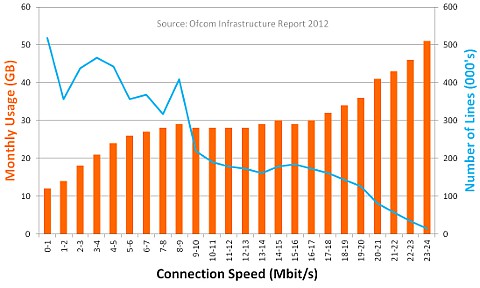
The obvious first:
- The chart shows that users with connection speeds of below around 5 Mbps do not consume as much data as those with faster connections. This is relatively obvious because the slower the connection, the lesser the ability to consume data. A user with a 1 Mbps connection would have to use their connection 5 times longer to download the same amount of data as a user with a 5 Mbps connection.
- The chart also shows that those who specifically elect to have a very high speed connection of over 16 Mbps consume more data than those with a slower connection. In effect, those who are paying for higher speed connections (which accounts for approximately 10% of all connections) are doing so because they actually want to use them.
What is not obvious and is quite surprising is that for those with connection speeds in the range of 6 to 16 Mbps, the amount of data they consume each month remains remarkably consistent (at around 28 Gbytes). Having a faster connection does not lead to using more Internet. It thus seems that there is a natural plateau of usage for an average user that is pretty consistent. And that plateau can be reached with a connection speed of 5 Mbps or greater.
Whilst the height of this plateau will inevitably rise as the number of connected devices in homes increases, it does suggest that, for today's British household, a connection speed of 5 Mbps or greater, with a data cap of 40 Gbytes per month (to allow for the occasional peak now and then) would satisfy around 90% of Internet users. Returning to the question of superfast broadband, it therefore seems somewhat gung-ho to be spending hundreds of millions of pounds investing in a fibre-based system which, even Dr Ungar admitted, would only ever reach around two-thirds of the population.
Terrestrial wireless networks (3G) can already deliver the kind of speeds required (HSPA+ offers connection speeds of up to 42 Mbps and even faster if MIMO antennas are used) and tariffs with unlimited data (subject to the usual fair use policies) can be had for around GBP20 per month. Even satellite broadband tariffs, often seen as uneconomical, can offer connection speeds of 20 Mbps with unlimited data download for around GBP35 per month. As things stand, both 3G and satellite networks can provide speeds and packages that exceed what Ofcom has shown to be the average requirement of a typical Internet user of today. As with all such technologies, as time progresses, they will improve and may well stay ahead of requirements.
 What Dr Ungar also pointed out was that the 'last few metres' of almost all Internet connections today are wireless, whether it is the few metres from the WiFi hub to the tablet, or from the cellular mast to the smartphone. To support the kinds of speeds likely to be necessary in the future, it is almost certain that fibre will be needed to deliver connections to wireless access points. In cities these are likely to be homes, streetlamps and anywhere else that a wireless hub can be located. Outside these areas, the availability of fibre will be sparse.
What Dr Ungar also pointed out was that the 'last few metres' of almost all Internet connections today are wireless, whether it is the few metres from the WiFi hub to the tablet, or from the cellular mast to the smartphone. To support the kinds of speeds likely to be necessary in the future, it is almost certain that fibre will be needed to deliver connections to wireless access points. In cities these are likely to be homes, streetlamps and anywhere else that a wireless hub can be located. Outside these areas, the availability of fibre will be sparse.But the good news is, that in rural areas, existing wireless technologies can already deliver the kinds of speeds and data packages that meet the needs of the everyday Internet user. The so-called digital divide between urban and rural areas can already be spanned using existing technologies and services (in fact even Ferrets can do it), all that's needed is for regulators to take a step back and recognise that superfast broadband is not always necessary and that, by association, fibre is not necessarily the solution to every ill. A more balanced investment strategy that takes into account the strengths and weaknesses of each of the possible Internet connectivity solutions, and levels the playing field between them, might yield much greater public satisfaction.
Monday 4 February, 2013, 05:57 - Spectrum Management
Posted by Administrator
Wireless Waffle has reported many times on the issue of jamming. Jamming, put simply, is the transmission of one radio signal in such a way as to intentionally block another one from being received. It is the intentional nature of jamming that distinguishes it from other kinds of radio interference. Posted by Administrator
Usually jamming is used for the purposes of disrupting something that the person doing the jamming does not wish to be received. Recently the BBC's satellite services have been jammed by both Syria and Iran who do not want the BBC's version of the news to reach their citizens. To this end, jammning is also illegal, as any kind of intentional radio interference usually is.
There are instances where jamming is sanctioned. In jails in some countries, for example, jammers which block cellular frequencies are used to stop inmates from using mobile phones to communicate to the outside world. Cellular jammers are also used in some mosques to ensure that peace and quiet is not disrupted by the 'Grande Valse'. It is believed that some theatres and cinemas also use cellular jammers to stop mobile phones spoiling the show. Unless explicit authority is gained fromt the regulator of the country concerned, though, the use of jammers, even where the purpose may seem harmless remains illegal. The illegality of jamming means that it is not usually advertised by those doing it.
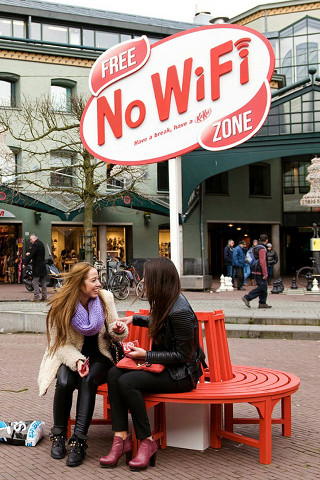 So step forward chocolate bar Kit Kat who has established 'no WiFi' benches in the Dutch capital Amsterdam. At these benches WiFi is jammed with the idea being that you can go and sit on them and disconnect from the hecticities of daily life and 'have a break, have a Kit Kat'. An interesting question therefore arises as to whether the activities of Kit Kat are illegal or not. Whilst jamming per se is normally illegal, the bands in which WiFi operates (both 2.4 and 5 GHz) are licensed for many more services than just WiFi. In the 2.4 GHz band, for example, it is also legal to operate wireless video cameras, bluetooth, microwave ovens, cordless phones, remote control toys, and many more devices. Some of these devices would have the potential to knock-out WiFi links. CCTV cameras, for example, transmit a continuous signal which would do a good job of jamming WiFi and other services that were nearby.
So step forward chocolate bar Kit Kat who has established 'no WiFi' benches in the Dutch capital Amsterdam. At these benches WiFi is jammed with the idea being that you can go and sit on them and disconnect from the hecticities of daily life and 'have a break, have a Kit Kat'. An interesting question therefore arises as to whether the activities of Kit Kat are illegal or not. Whilst jamming per se is normally illegal, the bands in which WiFi operates (both 2.4 and 5 GHz) are licensed for many more services than just WiFi. In the 2.4 GHz band, for example, it is also legal to operate wireless video cameras, bluetooth, microwave ovens, cordless phones, remote control toys, and many more devices. Some of these devices would have the potential to knock-out WiFi links. CCTV cameras, for example, transmit a continuous signal which would do a good job of jamming WiFi and other services that were nearby.It would therefore be possible (and legal) to run a number of wireless cameras, on adjacent frequencies such that the whole 2.4 GHz band was jammed. Around 4 wireless cameras would be needed to do this. Now disconnect the camera and just put the transmitter in place and this remains legal (as it is the transmitter which is regulated, not the content). Lo and behold, it would be legally possible to jam all WiFi signals in a limited location. Whilst this is legal from an equipment perspective, whether or not doing this for the purpose of jamming WiFi rather than for transmitting video pictures opens up another legal issue. Article 15 of the ITU radio regulations says:
All stations are forbidden to carry out unnecessary transmissions, or the transmission of superfluous signals, or the transmission of false or misleading signals, or the transmission of signals without identification
Signals that were there for the purpose of stopping other signals being received would surely be 'superfluous'. In addition, article 45 of the ITU radio regulations states:
All stations, whatever their purpose, must be established and operated in such a manner as not to cause harmful interference to the radio services or communications of other Member States or of recognized operating agencies, or of other duly authorized operating agencies which carry on a radio service, and which operate in accordance with the provisions of the Radio Regulations
 So if the purpose of running the wireless cameras was specifically to jam WiFi signals, and assuming that those WiFi signals were operating in accordance with the provision of the ITU Radio Regulations, they would remain illegal.
So if the purpose of running the wireless cameras was specifically to jam WiFi signals, and assuming that those WiFi signals were operating in accordance with the provision of the ITU Radio Regulations, they would remain illegal. Whether the Kit Kat 'WiFi free' areas are legal or not is therefore a subject that is, perhaps, open for discussion. Whether they are a good idea is equally subject to debate. Whether or not Kit Kat's are the right chocolate bar to have with a cup of tea (or coffee) during tea-breaks is, though, surely not a question that requires much debate. After all, they can't be all bad, if Cheryl Cole recommends them, right?
Following the recent Wireless Waffle post about Wes's excellent Soldery Song, it has been noted that the terms 'C-Band' and 'Ku-Band' were thrown around casually, as if everyone understands what these mean. For the benefit of those who don't, here's a short description of what they're all about:
 It is perhaps no surprise that in the battle to gain access to Ka-Band, some of those doing the fighting are going to lose out. This seems to have happened to Australian satellite company NewSat. Recently both Morgan Stanley and Lazard have pulled out of the programme raising funds for the launch of NewSat's Jabiru 1 satellite. Digging into the economics of NewSat, it appears that the numbers just don't add up. The cost of their capacity would be around 50% higher than that of existing Ka-Band satellite operators, which might be a difficult sell when trying to raise lots of capital to build and launch a new satellite.
It is perhaps no surprise that in the battle to gain access to Ka-Band, some of those doing the fighting are going to lose out. This seems to have happened to Australian satellite company NewSat. Recently both Morgan Stanley and Lazard have pulled out of the programme raising funds for the launch of NewSat's Jabiru 1 satellite. Digging into the economics of NewSat, it appears that the numbers just don't add up. The cost of their capacity would be around 50% higher than that of existing Ka-Band satellite operators, which might be a difficult sell when trying to raise lots of capital to build and launch a new satellite.
 From the figures on their web-site, NewSat were going to pay Lockheed Martin US$550 million to build and launch their 'bird'. The resulting satellite would operate in a total of around 8.4 GHz of Ka-Band spectrum. Compare that to UK satellite company Avanti who paid US$400 million for their bird, but which accesses 11 GHz worth of Ka-Band spectrum. Do the maths and you see that NewSat would be paying approximately US$66 million to access each GHz of spectrum, whereas Avanti paid only US$36 million. This difference in cost is borne out in prices too, with NewSat claiming to be aiming to charge customers US$1.3 million for a transponder for 12 months. The equivalent price for Avanti is around US$0.9 million.
From the figures on their web-site, NewSat were going to pay Lockheed Martin US$550 million to build and launch their 'bird'. The resulting satellite would operate in a total of around 8.4 GHz of Ka-Band spectrum. Compare that to UK satellite company Avanti who paid US$400 million for their bird, but which accesses 11 GHz worth of Ka-Band spectrum. Do the maths and you see that NewSat would be paying approximately US$66 million to access each GHz of spectrum, whereas Avanti paid only US$36 million. This difference in cost is borne out in prices too, with NewSat claiming to be aiming to charge customers US$1.3 million for a transponder for 12 months. The equivalent price for Avanti is around US$0.9 million.
This may not yet be a Ka-tastrophe (groan) or even a Ka-lamity (double groan) for NewSat. NewSat suspended trading in its shares in November to give it time to re-think it's financing strategy. Maybe there is still a 'hope in heaven' for those communities that NewSat was intending to serve, if, of course, the other satellite operators don't get there first!
- C-Band (in satellite terms) refers to frequencies in the range of roughly 4 to 8 GHz. C-Band satellites are commonplace in areas where there is very heavy rainfall (eg tropical areas) as, using relatively low microwave frequencies, signals propagate better and suffer fewer rain fades. It's not the total amount of rain that matters, it's the voracity of the downpours.
- Ku-Band refers to frequencies roughly in the range of 10 to 15 GHz (the 'roughly' refering to the fact that uplinks and downlinks work in different bands that may or may not be within this range but are at least somewhere nearby). Ku-Band is the band most commonly used for digital satellite television broadcasting anywhere that it doesn't rain too heavily (eg most non-tropical areas). In many areas, the geostationary arc is near saturation in Ku-Band, with satellites positioned every 2 degrees or so. Some satellite operators have tried to launch broadband internet services in this band but the high levels of congestion make it difficult to find the space to do so.
- Ka-Band refers to frequencies roughly in the range of 20 to 30 GHz. Ka-Band is the relative newcomer on the block (though Italsat F1 conducted some tests in this band in the early 1990s). With Ku-Band becoming congested with broadcasting, satellite operators wishing to offer broadband services are increasingly turning to Ka-Band to do so and it is fast becoming the most hotly contested band for new satellite services. Already popular in the US, it is now being successfully commercialised in Europe and Africa. In emerging countries, where terrestrial (including wireless) broadband services are unlikely to be rolled-out any time soon, the use of Ka-Band satellite broadband is likely to open up Internet access to millions of people who wouldn't otherwise have a hope of getting a decent connection.
 It is perhaps no surprise that in the battle to gain access to Ka-Band, some of those doing the fighting are going to lose out. This seems to have happened to Australian satellite company NewSat. Recently both Morgan Stanley and Lazard have pulled out of the programme raising funds for the launch of NewSat's Jabiru 1 satellite. Digging into the economics of NewSat, it appears that the numbers just don't add up. The cost of their capacity would be around 50% higher than that of existing Ka-Band satellite operators, which might be a difficult sell when trying to raise lots of capital to build and launch a new satellite.
It is perhaps no surprise that in the battle to gain access to Ka-Band, some of those doing the fighting are going to lose out. This seems to have happened to Australian satellite company NewSat. Recently both Morgan Stanley and Lazard have pulled out of the programme raising funds for the launch of NewSat's Jabiru 1 satellite. Digging into the economics of NewSat, it appears that the numbers just don't add up. The cost of their capacity would be around 50% higher than that of existing Ka-Band satellite operators, which might be a difficult sell when trying to raise lots of capital to build and launch a new satellite. From the figures on their web-site, NewSat were going to pay Lockheed Martin US$550 million to build and launch their 'bird'. The resulting satellite would operate in a total of around 8.4 GHz of Ka-Band spectrum. Compare that to UK satellite company Avanti who paid US$400 million for their bird, but which accesses 11 GHz worth of Ka-Band spectrum. Do the maths and you see that NewSat would be paying approximately US$66 million to access each GHz of spectrum, whereas Avanti paid only US$36 million. This difference in cost is borne out in prices too, with NewSat claiming to be aiming to charge customers US$1.3 million for a transponder for 12 months. The equivalent price for Avanti is around US$0.9 million.
From the figures on their web-site, NewSat were going to pay Lockheed Martin US$550 million to build and launch their 'bird'. The resulting satellite would operate in a total of around 8.4 GHz of Ka-Band spectrum. Compare that to UK satellite company Avanti who paid US$400 million for their bird, but which accesses 11 GHz worth of Ka-Band spectrum. Do the maths and you see that NewSat would be paying approximately US$66 million to access each GHz of spectrum, whereas Avanti paid only US$36 million. This difference in cost is borne out in prices too, with NewSat claiming to be aiming to charge customers US$1.3 million for a transponder for 12 months. The equivalent price for Avanti is around US$0.9 million.This may not yet be a Ka-tastrophe (groan) or even a Ka-lamity (double groan) for NewSat. NewSat suspended trading in its shares in November to give it time to re-think it's financing strategy. Maybe there is still a 'hope in heaven' for those communities that NewSat was intending to serve, if, of course, the other satellite operators don't get there first!

